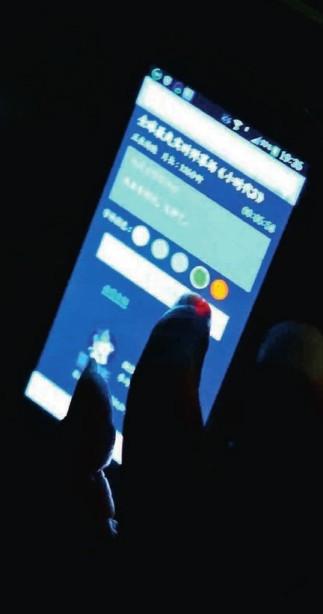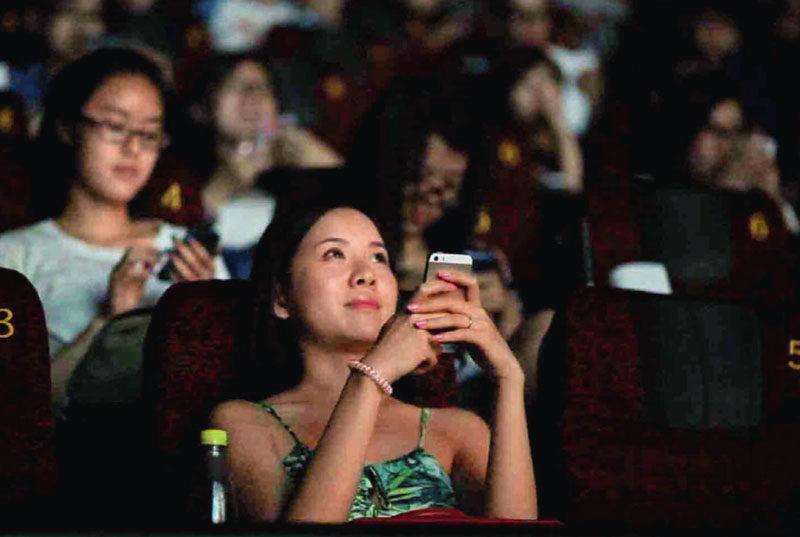A New Viewing Experience in the Living Room
By staff reporter VERENA MENZEL


WATCHING television alone? When television sets – impossibly small and infuriatingly expensive – first appeared in Europe in the 1930s, this concept was unheard of. In Germany, where Im from, back then 50 people would huddle in front of one screen the size of two postcards to watch a show in a special “TV room.”
In the following decades TV sets were constantly upgraded with higher resolution, bigger screens, and eventually, color images. But watching TV remained a social event, offering a chance for the family to gather in the living room, or a group of friends in a local pub.
The trend today couldnt be any more different. The majority of people these days are usually alone when looking at a screen, of any device. Computers, smartphones, and tablets are preferred over TV sets nowadays, even when we are at home and not on the go. However distracting and disruptive, modern technol- ogy is deft at facilitating people to follow their nature. It is widely acknowledged that humankind is by nature gregarious, as are sentimental TV viewers. This explains why bullet screens have become such a big hit in modern times.
From Japan to China
The technology behind the bullet screen is nothing new, but it has thrived at full steam in China over the past year and a half.
As the name indicates, a bullet screen allows the audience to “shoot at” the screen via a computer or mobile phone with their comments, which appear as subtitles in real time, so other viewers can also see them. This is obviously different from conventional online comments, which are placed in a particular section of a web page, and are not visible to the viewers unless they chose to scroll down. Instead, a bullet screen allows the audience to post remarks that pop up all over the scenes broadcast, sometimes to the extent that they constitute a barrage of words that obscures the broadcast.
The bullet screen first appeared in Japan, and gained in popularity owing to the gaming website, Nico-Nico. It was introduced to China in 2008 and was favored by young netizens, particularly those born in the 1990s, who normally spend several hours every day scouring video, animation, and gaming websites. AcFun and Bilibili were the two first Chinese websites to embrace the bullet screen, and have remained at the forefront of this sector thus far.
Over the past years, bullet screen technologies have come into the vision of more Internet users. Tudou, a leading video-sharing website in China, debuted its bullet screen service in 2012, and has made remarkable headway in this area. Rivals Iqiyi and Youku soon followed suit, prompting the bullet screen to become a must for almost all video-sharing websites. But they often offer viewers the choice to turn off the function if they find the “bullets” too disruptive.
Interactivity the Drawing Card
Interactive video brings to the audience virtual companions in the small, solitude space between the tip of ones nose and the screen, normally a mere 40 cm. A line of mockery or applause, or a brief exchange of thoughts make the viewing experience more exciting and enjoyable, whatever is on air.
A happy marriage between online video and social networking, the bullet screen strongly appeals to young people, who often favor interactivity over the content of the video. In fact, shoddy films and TV series and bland commercial videos are the most targeted by such“bullets,” and consequently receive a high audience rating. Their value lies not in the content, but in the opportunities for viewers to poke fun at them through the interactive function, so few people complain about the text messages scattered all over the screen.
As the president of Nico-Nico explained, “The video may be boring in itself, but the audience can amuse themselves.” Those who find the bullets a nuisance can turn off the function with one click.
According to a Bilibili survey, of the 150 people interviewed, 92 percent said that the bullet screen was entertaining; 45 percent felt uncomfortable with non- interactive videos after trying the bullet screen; and 80 percent agreed with most of the comments projected to the screen in the course of viewing.
“Many older people deem the bullet screen as a folly or prank, but younger people take it as the norm, part of the viewing experience,” said Tudou.com President Yang Weidong. “As we can see, the influence of this technology is on the rise.”
Other media are also jumping on the bandwagon in an attempt to lure young audiences. Cinemas made the first try on August 2, 2014, when Shanghai Ever Shining Circuit Co., Ltd launched a bullet screen for the release of the animated film The Legend of Qin. Two days later several movie theaters in Beijing also embraced this technology when airing the comic feature Tiny Times 3. Kung fu film Brotherhood of Blades followed suit on August 7.
It is easy to shoot bullets at the silver screen. All the audience has to do is connect a mobile device to the cinemas Wi-Fi, log on to a particular web page, and type a comment. The remarks are subject to automatic screening for sensitive words before they are broadcast. If anyones handset runs out of power in the course of the viewing, he or she can send a help message to an emergency number, and the theater staff will arrive with a charger.
Many foreign media including the New York Times and Germanys Der Spiegel have covered the rise of the bullet screen extensively. Movie theaters and distributors see great potential in it. Le Vision Pictures, distributor of Tiny Times 3, held that the bullet screen is a strong marketing tool. Its PR manager, Enya Sun, told the New York Times:“We would like to launch a social experiment, and promote it among the young people.”
Last year, Chinas TV also opened up to the bullet screen. When Hunan Satellite TV live broadcast the highly anticipated China Golden Eagle TV Art Festival on October 12, 2014, it allowed the audience to “shoot bullets” during certain parts of the process. This was the first attempt by Chinese television to employ a bullet screen. As is customary in China, any sensitive comments were censored.
Expansion amid Controversy
It is no surprise that not everyone buys into this new technology. The critics say that installing bullet screens in movie theaters is a marketing trick that compromises the broadcast. KTV (Kill TV), producer of the popular online film review program open Film Course, was quoted as saying: “The bullet screen is a form of entertainment. People are pulled towards it for its interactivity, instead of love for films. It shows little respect for the productions and their directors.”
Chinese film directors, understandably, frown at this technology. He Ping, former secretary general of China Film Directors Guild, accused it of sabotaging the directors aesthetic intent for a film. In an interview with China Youth Daily, he suggested the use of the bullet screen in a film should be approved by its screenwriter and director.
Wang Yi, an Internet culture researcher, thinks differently. He sees the bullet screen as a counterattack to poorly produced films and programs. It is a long existing phenomenon among young Internet users to collectively mock artistically worthless productions via new media, and enjoy themselves in the course. A new word has been coined for such activity, tucao, meaning to jibe or complain.
No one knows if this trend will stick and grow for TV and films. Unlike the computer, handset and other mobile devices, TV and film viewers cannot cancel the bullet function on the bigger screens. But still, young people, with their penchant for real-time comments from on- line experience, readily accept it in cinemas and on their TV sets.
Bullet screen supporters also discern a huge virgin territory in Chinas exploding App sector, into which bullet screen technology can be finely attuned. Joke website Jiecao is an example. It offers an App with which customers can add their remarks by pressingand-holding the part of text or picture that they have something to say about. Their messages then pop up over the text or picture to be shared with other viewers.
Chinas media workers and advertisers are experimenting with ways to introduce interactive functions of social media into conventional media, integrating the computer, mobile phone and TV screens and attempting to transform the traditional cinema into a multi-media space.
Operators of large video portal websites are confident about the future of the bullet screen, and are now preparing for its commercialization. Tudou has commenced cooperation with cinema operators over the technology of applying bullet screen in films. Tudou President Yang said, “We have garnered much experience of the application of this new technology and plan to use it in 5,000 movie theaters someday.”
“The bullet screen underlines the social elements in peoples demand for shared media, and also meets the desire of Internet users to express themselves,”said Wang Yi. It gives people the feeling of traveling back to the time when they watched TV in groups, laughing or booing together. Instead of with real people sitting around you, the same experience, exchanging thoughts and being part of a group, is recreated with virtual technology. Technologies are always evolving, but human nature has remained and will continue to remain unchanged, and solitude is not part of it.

